Friday, 2:35pm
14 February 2025
Relationships on show
Jane Connory, Fanny Suhendra and Claire Fisher collaborate to flip the script on graphic design exhibitions and visually narrate the history of relationship agencies in Australia.
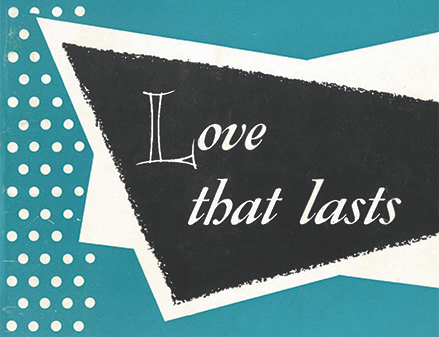
Trigger Warning: This article outlines discussions of domestic and sexual violence. Reader discretion is advised.
Many exhibitions of graphic design focus on how printed artefacts tell stories of the discipline itself. They often display aspirational and beautifully refined work, like cataloguing the career of a design hero or an established historic style. However, a recent installation in the National Gallery of Australia used graphic design ephemera to narrate and celebrate 75 years of Relationships Australia, a respected and leading provider of relationship support services in the country.
The exhibition showcased otherwise aesthetically insignificant graphic design works produced by various providers to tell a critical and ever-changing story of something other than the field of design. Together the chronological collection of over 30 artefacts narrated the evolving perception of marriage and relationships in Australia, which reinforce the importance of the graphic design discipline as a reflective cultural device and interpretive medium, as well as our need to take more notice of the less highbrow design that impacts our world.
New Beginnings, 1980s, a book about separation and divorce from the Relationship Australia Victoria library.
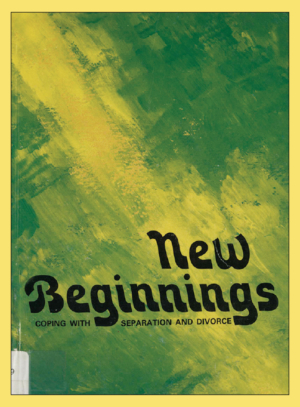
Marriage Guidance Council of Victoria (1957). Love that lasts. Forward by David Mace. Prahran, Victoria. All photography by Claire Fisher.
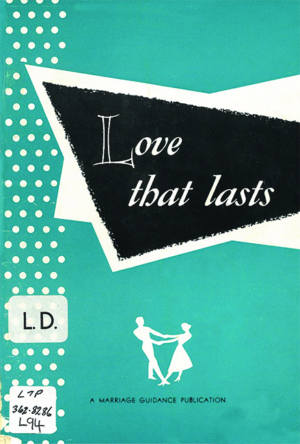
Focusing on educating people about marriage and family life, relationship support began as religiously led marriage guidance in Australia following a series of talks presented by Dr W. L. Carrington, who was the chair of the Melbourne Marriage Guidance Council. These talks were later published into booklets like the one you see above.
In the 1950s, marriage was an ideal life goal in the postwar euphoria. This two-colour booklet cover illustrates a couple jiving and having fun as a metaphor for marriage: dance halls were a respectable place to meet a life partner in this era. The bold, dynamic graphics and typography, with a capital letter reminiscent of an illuminated manuscript, tell a story of a fairy tale ideal and hoping for happily ever after.
Marriage Guidance Council of New South Wales (1961). Focus on Marriage Guidance. Introduction by the Honourable Mr Acting Justice Selby, Sydney, New South Wales.
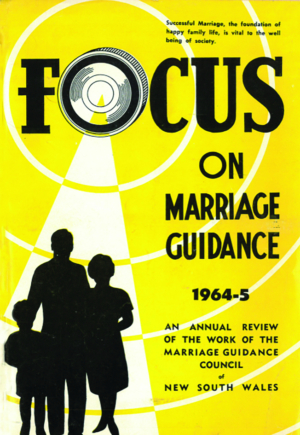
The Focus on Marriage Guidance booklet above was written by The Honourable Mr. Acting Justice Selby. It portrayed a shift in how divorce is perceived and how marriage guidance has evolved from just focusing on encouraging and protecting marriages regardless of the circumstances. Justice Selby was involved in divorce reformation and wanted to ensure equal rights for both parents, more attention to the welfare and custody of children and the provision of legal aid in certain divorce cases.
The bright yellow design speaks of an urgency in addressing the inequalities in Australian divorce law during the 1960s. The literal focus, shown as a photographic lens and bright white spotlight shining on the
black silhouette of a heteronormative family unit, shows that married life was the centre of the ‘well being of society’ as stated on the cover.
National Archives of Australia (1974). What do you think? pamphlet, Royal Commission into Human Relationships. Sydney, Australia.
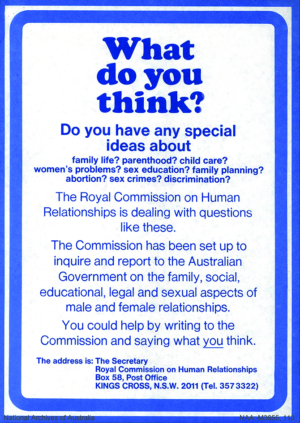
This leaflet from 1974, was widely distributed, with a circulation of 90,000 copies, inviting the public to contribute to the 1974 Royal Commission on Human Relationships. The terms of reference included sexuality, family violence, gender inequality, family planning and divorce. The initiative led to the no fault divorce law passing in 1975.
The bold versatility and ubiquity of the Cooper Black typeface during the 1970s, which is used in the headline of this leaflet, spoke to the importance of this initiative. By 1976, an unprecedented peak in the divorce rate was hit at approximately 4.6 per 1000 residents in the population. This gave greater autonomy for women and became a part of the surge for women’s rights in Australia. As feminism’s push for equality was felt, women were also given governmental access to a higher minimum wage, health care centres and childcare centres.
Select Bibliography on Conjugal Violence: Sociology, Psychology and Treatment. Marriage Guidance Council of NSW. Enfield, Sydney, 1984, by S. Sykes.
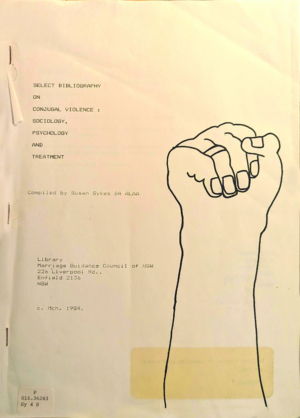
This collated bibliography from the 1980s shows an emerging acknowledgement of the effect of conjugal violence, now called domestic violence, on relationships. It also became a valuable resource as Marriage Guidance Councils evolved from a marriage preservation movement into a service agency.
The cover design shows a rudimentary illustration of a fist with a wide wedding band and short nails. Viewed as symbols of power throughout history, fists have been associated with political power or uprisings, be it for socialist, feminist or ethnic solidarity. In this instance it is a more literal interpretation of physical and sexual violence.
This imagery brings attention to one of the many reasons that leaving marriage can be more important that keeping it together, which again shows a shift in attitudes towards the institution as an ideal. Between 1981 and 1992 rape became a criminal offence in Australia which included the prosecution of rape within marriages. In 1986 the Domestic Violence Agencies Act was established in Australia’s capital, Canberra. So, although naive in style, this document’s directness was a landmark in the evolution of marriage in Australia.
Annual Report (2002). Relationships Australia Inc. Canberra, Australia Capital Territory.
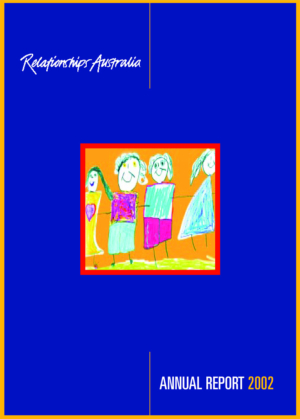
Annual reports from the 1990s through to the 2000s chronicle funding issues, as the expanding service offerings and new training requirements were not appropriately supported by funders. Visually, we can see the clear shift from couples and marriages to other familial and collegial relationships. The clear and consistent brand language in these documents present a professional service that has moved a long way from being the religious based group with untrained support worker of its origins. The sketch featured on this cover was created by a child who attended RA services and shows the importance given to children and their contribution and priority in relationships and families.
Relationships Australia (2018). Walking Together Relationships Australia Indigenous Network | Action Plan on a Page. Canberra, Australian Capital Territory.
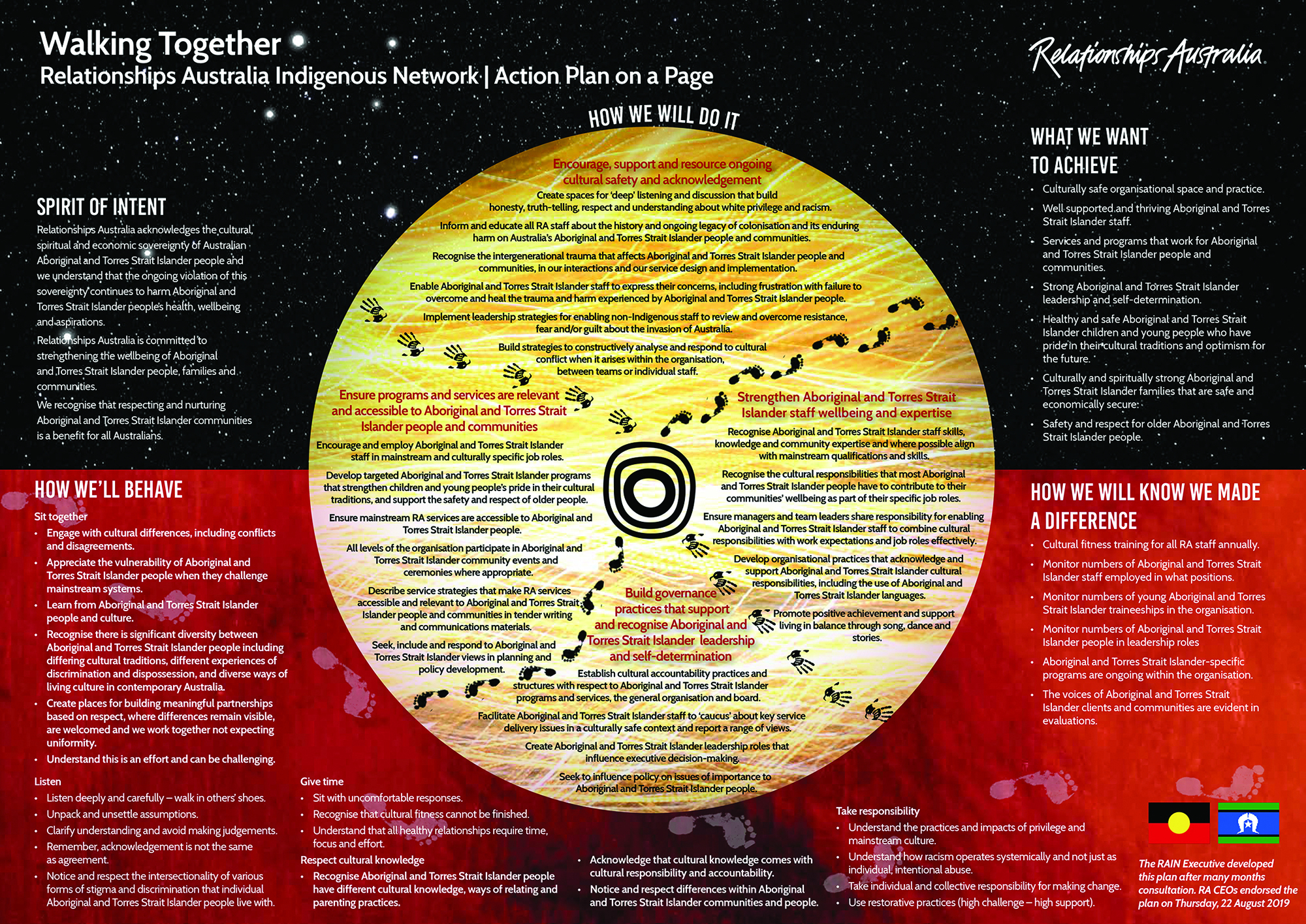
Relationships Australia’s Indigenous Network was established in 2007. The ‘Action Plan on a Page’ was developed by the network and demonstrates a commitment to strengthening the wellbeing of Aboriginal and Torres Strait Islander people, families and communities, and the work that must occur across the Federation to do so. An Aboriginal graphic designer was engaged to create this artefact, with the aim of embracing the diversity within the Indigenous visual traditions across Australia. The colours and layout reflect the Aboriginal flag, and the iconography is not specific to any one geographic location across the country.
Suhendra, F. (2023). ‘Social Media Video’. Swinburne University of Technology. Hawthorn, Melbourne.
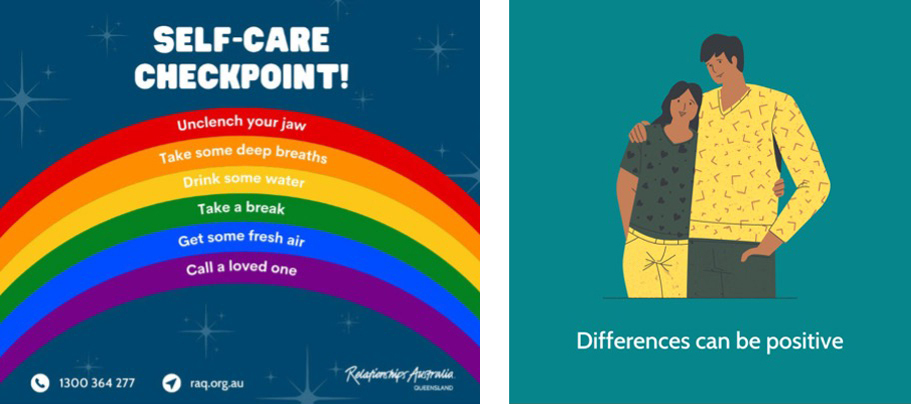
The political environment of the late 1990s and 2000s showed promise of a more inclusive society and positive view of the diversity within relationships. On May 26, 1998 the first National Sorry Day was held in Australia to acknowledge the injustices Aboriginal and Torres Strait Islander families have faced during colonisation.
Relationships Australia began engaging with social media, showing a commitment to becoming more inclusive and diverse in both its service offerings and visual representation. The current service offerings support all kinds of relationships, including LGBTQIA+ communities, First Nations peoples as well as culturally and linguistically diverse families. This reflected a wider shift in Australia’s psyche towards relationships. In 2017, a compulsory National postal vote made same sex marriages legal across Australia. And Relationships Australia's access to stock imagery and social media gave them many opportunities to visually and freely represent the importance of diverse and inclusive relationships and the positive work they are doing in this space to a wide audience.
Dr Jane Connory and Dr Fanny Suhendra, designers, writers and researchers at Swinburne University of Technology, Melbourne, Australia. Claire Fisher is the National Research and Project Manager at Relationships Australia National.
Eye is the world’s most beautiful and collectable graphic design journal, published for professional designers, students and anyone interested in critical, informed writing about graphic design and visual culture. It is available from all good design bookshops and online at the Eye shop, where you can buy subscriptions and single issues.
